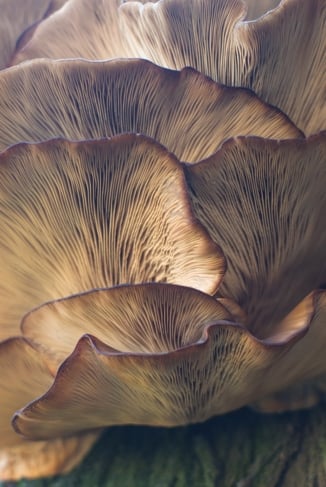
As a human being, when you think of something that is “like you,” what do you imagine?
In 2000, Dr. Michael Hathaway, professor of anthropology at Simon Fraser University, found himself living with elephants. He was doing anthropological research in a village in southern China, where humans and animals shared a rainforest.
The elephants were powerful, with complex social dynamics and behaviors that evolved with time. They revolted against the help of a local conservation project designed to protect them. The elephants were also big fans of rice. Many would turn down plentiful food in the forest to face down villagers banging pots and pans, trying to defend their rice paddies from their thick-skinned neighbors.
Years later, Hathaway came to question the human-centered dogma of anthropology, and he wrote a piece looking at these elephants as agentic beings with the power to shape their own lives. From there, his research narrowed in on fungi.
Although more understated than rice-loving elephants, could fungi also be regarded as agentic beings who affect their own world? And as we learn more about the incredible potential of fungi to benefit our health and our environment, how can we ensure that we make use of them in a sustainable way?
What do we have in common with fungi?
More than you might think. Fungi inhale oxygen and exhale carbon dioxide. Their skin is made of chitin, the same material found in the hard shell of a beetle or the scale of a fish. They decide if, when, and where to germinate, and plant-dependent spores will be choosy about which plant they fuse with. Fungi will actively forage for their food, and carnivorous fungi will even use specific methods to hunt for nematodes (round worms). If faced with a multiple-choice decision, a fungus will not always take the same path.
“There is a lot we could learn from mushrooms,” says Yarrow Willard, a clinical herbalist. “Their mycelial nets share information and space more freely with one another than we humans often do.”
Hathaway agrees. “Fungi have kinship,” he says. “Taking a human-centric perspective of life will always limit our understanding of the world around us.”
Quiet genius
In 2010, when presented with oat flakes arranged in the pattern of Japanese cities around Tokyo, a fungus-like mold constructed a network of nutrient-channeling tubes deemed by engineers to be more efficient than the layout of the Japanese rail system.
Could fungi be one answer to our waste problem?
Given their complex behaviors, it’s no surprise that fungi play a critical role in ecosystems: They are potent decomposers. Scientists have found that enzymes in fungi can break down toxins in water, including at sewage treatment plants, and remediate toxins in soil. Mycelial fungi can also neutralize endocrine-disrupting plastics found in numerous commercial and industrial products, preventing them from leaching into the environment and the human body.
These properties mean that fungi offer opportunities for radical redesign. In 2018, a group of students at the University of British Columbia won first place in a biology-design challenge for their creation of a mycelium-based toilet that they designed for use in refugee camps.
The reason we don’t hear more about the potential of fungi to transform our environment so radically is because of challenges around consumer awareness, says Willard. “We need to demand government legislation—for example, taxing waste streams—that gives big companies a financial incentive to get on board,” he says. “In the meantime, mycelial waste remediation is a brilliant option for the small-scale farmer.”
So … what’s mycelium?
Mycelium is the root system of a fungus that gathers and absorbs nutrients, while the fruiting bodies of mycelium are what we call mushrooms.
How can we dig deeper?
The first step to appreciating the hidden life of fungi is to think more deeply about the unique role that they play in ecosystems.
“Looking at mushrooms as world-changing organisms gives us a new appreciation for the network of fungi, plants, bacteria, and animals that rely on their being,” says Hathaway.
Of course, this new perspective on fungi can sit in tension with our desire to capitalize on their positive benefits. Is it possible to reconcile this, and, if so, how?
According to Hathaway, one answer lies in the Indigenous principles of reverence, humility, and reciprocity. These principles celebrate the social, ecological, and spiritual interconnectedness between human, animal, and spirit. Practicing them means you take only what you need, are aware of how you take it, and appreciate what has been given to you—all to ensure future generations are not put in peril.
“When you approach a fungus, be curious about its liveliness,” says Hathaway. “Imagine its liveliness as just as important as our own, in ways more complex than we can even begin to imagine.”
The healing power of mushrooms
To support strong immune function, clinical herbalist Yarrow Willard recommends supplementing with a blend of three to five mushrooms. Here are his top five picks.
Chaga (<Inonotus obliquus>) may help build up our defenses against viruses and bacteria and also suppress the growth of cancerous cells.
Cordyceps (<Cordyceps sinensis>) is used to help boost the immune system, increase aerobic endurance, and enhance respiratory function.
Lion’s mane (<Hericium erinaceus>) helps promote healthy neural and nerve function while easing anxiety and depression.
Reishi (<Ganoderma lucidum>) is used to increase energy levels and support healing.
Turkey tail (<Coriolus versicolor>) may calm your body’s oxidative stress response and protect against neurodegenerative disease.
Ethical harvesting practices
If you take a mushroom supplement, be sure to choose an ethical supplier. For example, when it comes to revered chaga mushrooms, large-scale commercial harvesting would quickly decimate native populations. Willard’s plant medicine company uses chaga extract from Siberia, where producers designate and protect large areas of forest for chaga cultivation.
While Willard encourages learning more about fungi, he is concerned that the newfound popularity of mushroom foraging is encouraging improper harvesting practices. To avoid damaging trees and delicate forest ecosystems, foragers should harvest only the fruiting body of the mushroom, leaving the bark layer intact. Willard also recommends growing some types of mushrooms at home using old coffee grounds as a base.
“Mushrooms are regenerative, and that’s a great metaphor for how to live our own lives,” says Willard. “How do we take our waste and turn it into something of value?”
















